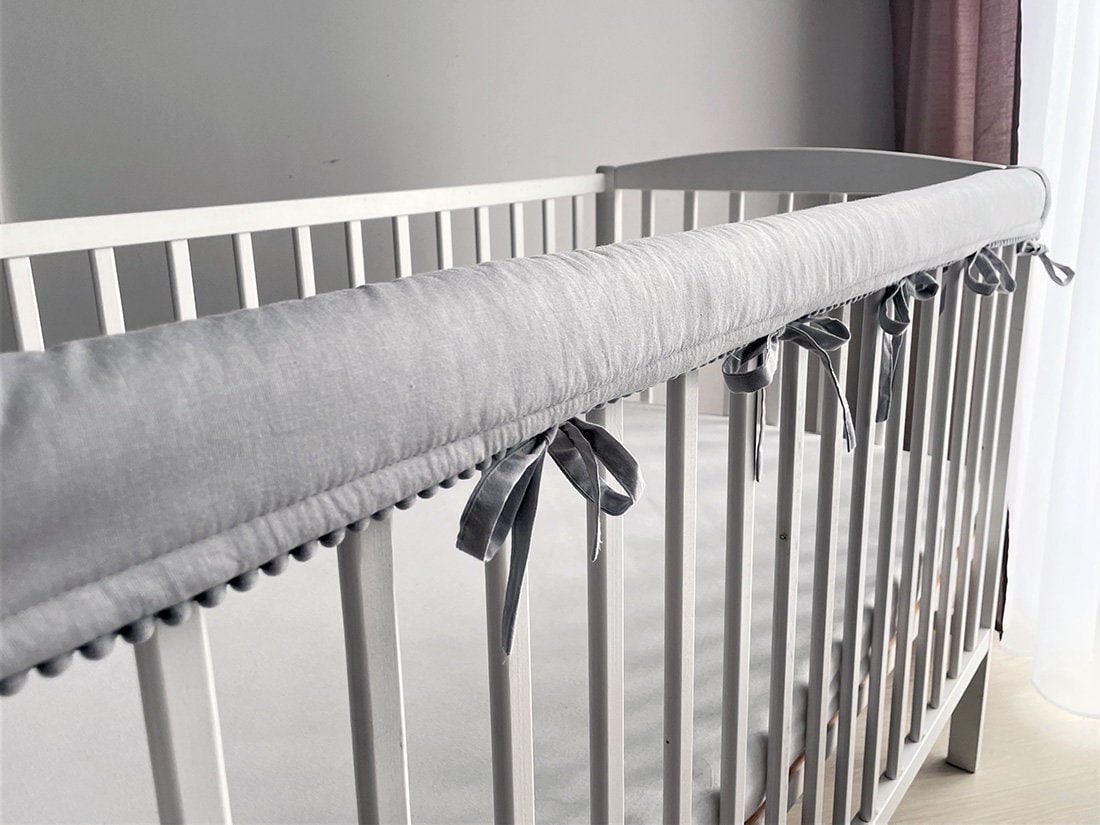The Ultimate Safety-First Guide to Choosing a Crib Rail Cover for Teething
It’s a sound every new parent learns to dread. That quiet, persistent gnaw, gnaw, gnaw coming through the baby monitor.
You peek into the nursery to find your little one, proud as can be, chewing on their crib rail like it’s a personal teething toy.
Your mind instantly races with two distinct worries: is my baby ingesting something harmful, and is my beautiful, expensive crib being destroyed?
For the Protective New Parent, this moment is stressful. But the solution is simple and incredibly effective: a crib rail cover for teething.
This article is your definitive guide to choosing one, putting your baby’s safety first so you can finally have some peace of mind.

Why a Crib Rail Cover Isn’t Just a “Nice-to-Have”
While it might seem like just another baby accessory, a good crib teething guard serves two critical functions.
It’s an essential piece of gear for protecting both your child and your nursery investment.
Priority #1: Protecting Your Baby’s Health
The primary reason to use a rail cover is to create a safe barrier between your baby’s mouth and the crib itself.
When a baby is chewing on a crib rail, there’s a real risk of them ingesting potentially harmful materials.
This includes old paint chips, splinters from the wood, or chemical-heavy wood varnish.
If your crib is older or a hand-me-down, the risks can be even greater, as it may contain toxins like lead or phthalates that have since been banned in children’s products. A non-toxic crib rail cover is the safest defense.
Protecting Your Nursery Investment
Let’s be honest: cribs are expensive. They are often the centerpiece of the nursery you spent so much time designing.
A teething baby with sharp new teeth can leave deep, permanent bite marks and strip the finish off a rail in a matter of days.
Using a cover preserves the beauty of your furniture, which is especially important if you plan to use the crib for future children or hope to resell it one day.
The Anatomy of a Safe Crib Teething Guard: A Buyer’s Checklist
Not all crib rail covers are created equal. When anxiety is high, it’s easy to get overwhelmed.
Use this simple checklist to ensure you’re choosing a product that is, above all, safe.
Material Matters: Insist on Non-Toxic and Baby-Safe
Your baby will be chewing directly on this product, so the material is non-negotiable.
- Look for: Food-grade silicone (the same material used in bottle nipples and pacifiers) or fabrics with an OEKO-TEX certification, which guarantees they’ve been tested and found free of harmful substances.
- Avoid: Any product that doesn’t explicitly state it is free of PVC, BPA, phthalates, and lead. If the description is vague, move on. Your baby’s safety is worth the extra diligence.
Fit & Fastening: It Must Be Secure
A loose or ill-fitting cover is a serious safety hazard. It can become an entrapment risk or a potential choking hazard if small parts come loose.
- Fastening Types: Look for secure methods like sturdy fabric ties, strong velcro that folds back on itself, or robust snaps. Avoid covers with decorative buttons or other small attachments that could be chewed off.
- Measure First: Always measure the length and width of your crib rails before you buy. A snug fit is a safe fit. The cover should not sag, droop, or be easily pulled off by a curious baby.
Cleaning & Maintenance: Keeping it Hygienic
Anything that goes in your baby’s mouth needs to be cleaned regularly to prevent the buildup of drool and bacteria.
- Fabric Covers: Check that they are machine-washable for easy and thorough cleaning.
- Silicone Covers: Ensure they can be easily wiped down with soap and water or, even better, are top-rack dishwasher-safe.
The Best Crib Rail Covers for Teething: Our Top Picks by Category
After reviewing countless products based on safety standards, durability, and real parent feedback, we’ve identified the best options for different needs.
Best Overall: The All-Around Silicone Guard
These covers are typically made of 100% food-grade silicone.
They are easy to install, incredibly easy to clean, and provide a satisfying texture for sore gums.
They offer robust protection for the crib rail and supreme safety for your baby.
Best Soft Option: The Plush Fabric Protector
If you prefer a softer look, an OEKO-TEX certified fabric cover is a great choice.
Many are lightly padded, offering a cushion in case of bumps.
Look for reversible options with different patterns to switch up your nursery style.
Best for Wide Rails: The Adjustable Wrap-Around Cover
Many modern or convertible cribs feature wide, flat top rails.
For these, you’ll need a cover specifically designed to wrap around and secure underneath, often with long velcro strips or multiple tie-downs.
Best Budget-Friendly Pick: The Simple & Safe Teething Rail
You don’t have to spend a fortune to get a safe product.
There are many simple, no-frills silicone or fabric options that are certified non-toxic and get the job done without breaking the bank.
Best for Style: The Reversible or Patterned Cover
Who says safe can’t be stylish?
Many brands offer covers in a wide array of colors and patterns to perfectly match your nursery decor.
Reversible fabric covers give you two looks in one.
Pro Tips for Installation and Use
Getting the most out of your crib rail cover involves more than just buying the right one.
How to Measure Your Crib Rails Like a Pro
Use a soft measuring tape.
For length, measure from one end of the rail to the other.
For width (or circumference), wrap the tape all the way around the rail to see how much material you’ll need to encircle it completely.
Step-by-Step: How to Install a Crib Rail Cover for Maximum Safety
- Start in the middle and secure the center of the cover first.
- Work your way outwards, fastening ties or velcro as you go.
- Ensure each tie is secured with a tight double knot. Trim any excessively long ends.
- Pull firmly on the cover to ensure there is no sagging or gapping. It should be taut against the rail.
A Simple Cleaning Schedule to Keep it Fresh
Plan to clean your rail cover at least once a week, or more often if your baby is teething heavily.
For silicone, a daily wipe-down is a good habit.
For fabric, having a backup cover is a lifesaver on laundry day.
Frequently Asked Questions (FAQ)
Are crib rail covers safe for my baby?
Yes, as long as they are chosen and installed correctly.
A safe cover is made from non-toxic materials, fits the crib rail snugly without any gaps, and is securely fastened so it cannot be pulled off by the baby.
When should I put a rail cover on my crib?
The best time is right before your baby can pull themselves up to a standing position in the crib, which is typically between 6 and 10 months of age.
This is when the chewing often begins.
Can a crib rail cover damage the wood finish on my crib?
No, a high-quality cover is designed to protect the finish, not harm it.
Issues only arise if moisture gets trapped underneath for long periods.
This is why regular cleaning and ensuring the rail is dry before reattaching the cover is important.
Do I need a cover for all four sides of the crib?
Usually, no.
Most parents find they only need a cover for the long front rail, as this is the most common target for teething.
However, if you notice your baby chewing on the shorter side rails, you can certainly purchase covers for them as well.
Conclusion: Protect Your Baby, Your Crib, and Your Peace of Mind
Choosing a crib rail cover for teething is a small but powerful decision that provides a dual layer of protection.
It shields your baby from harmful materials and saves your crib from damage, giving you one less thing to worry about.
By focusing on non-toxic materials, a secure fit, and easy maintenance, you can confidently select a product that keeps your baby safe.
Now you can rest a little easier, knowing those gnawing sounds are directed at a safe, clean surface.
Ready to find the perfect fit? Browse our curated list of safety-tested crib rail covers and enjoy peaceful nights knowing your little one is protected.

